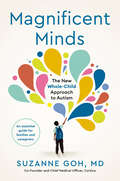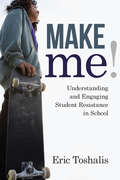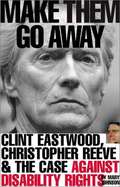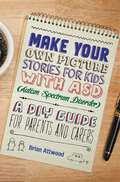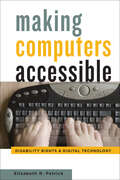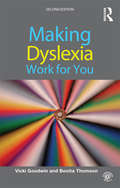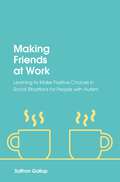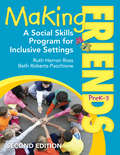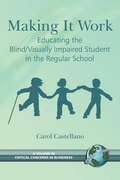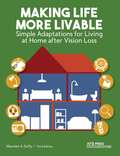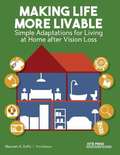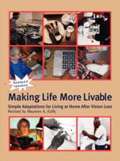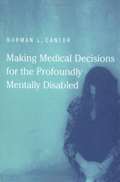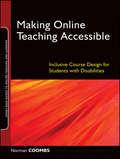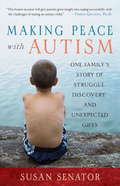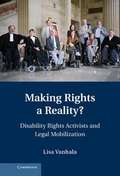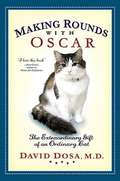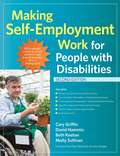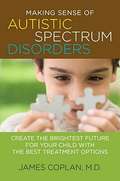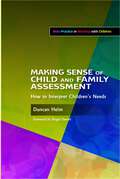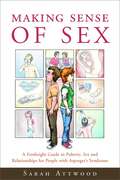- Table View
- List View
Magnets and Ladders: Spring/Summer 2017
by Active Voices of Writers with DisabilitiesMagnets and Ladders is an online literary magazine that features poems, short stories, memoirs, and personal essays by writers with disabilities. The magazine is divided into sections that reflect the content of selections and voice of the authors. Topics include: life events, memoir, science fiction, nature, current issues, music, art, travel, and the craft of writing. Stories and poems about holidays and the season are also featured. Although the authors published in Magnets and Ladders have disabilities, most of their writing is not about disability. These authors have had a multitude of enriching experiences and they are proud to share them with you.
Magnificent Minds: The New Whole-Child Approach to Autism
by Suzanne GohAn essential primer based on a renowned new model of care that is comprehensive and research based, while honoring the uniqueness of every childAn estimated one in thirty-six children in the United States is diagnosed with autism. New research has shed light on the many factors that determine a child&’s trajectory—but many parents are still navigating this complex terrain without a road map. Pediatric neurologist Dr. Suzanne Goh has spent decades working with autistic children, and in this practical and research-based guide she shares her renowned and revolutionary model of care: an innovative, whole-child approach that combines optimal medical treatment with the most effective strategies for advancing cognition, communication, and behavior. Demystifying a wide range of diagnostics and therapies and offering new insights into the neurological, biochemical, behavioral, and social factors that play a role in successful outcomes, the book is an essential resource for understanding all of autism—a strengths-based approach that helps parents design a comprehensive treatment plan. It is also a celebration of what each autistic person brings to the world—and how parents can best nurture the remarkable uniqueness of their child while setting them up for the future they envision.
Mainstreaming and the American Dream: Sociological Perspectives on Parental Coping with Blind and Visually Impaired Children
by Howard Nixon IIBased on in-depth interviews with parents and professionals, this research monograph presents a sociological framework for looking at the needs and aspirations of parents of blind and visually impaired children.
Major League Dad
by Gregg Lewis Christine Burke Tim BurkeTestimony of former Major League pitcher whose family adopted four special-needs children.
Make Me!: Understanding and Engaging Student Resistance in School (Youth Development and Education Series)
by Eric ToshalisIn this groundbreaking book, Eric Toshalis explores student resistance through a variety of perspectives, arguing that oppositional behaviors can be not only instructive but productive. All too often treated as a matter of compliance, student resistance can also be understood as a form of engagement, as young people confront and negotiate new identities in the classroom environment. The focus of teachers&’ efforts, Toshalis says, should not be about &“managing&” adolescents but about learning how to read their behavior and respond to it in developmentally productive, culturally responsive, and democratically enriching ways. Noting that the research literature is scattered across fields, Toshalis draws on four domains of inquiry: theoretical, psychological, political, and pedagogical. The result is a resource that can help teachers address this pervasive classroom challenge in ways that enhance student agency, motivation, engagement, and academic achievement. The coauthor ofUnderstanding Youth: Adolescent Development for Educators (Harvard Education Press, 2006), Toshalis blends accessible explanations of theory and research with vignettes of interactions among educators and students. In Make Me!, Toshalis helps teachers perceive possibility, rather than pathology, in student resistance.
Make Them Go Away: Clint Eastwood, Christopher Reeve and the Case Against Disability Rights
by Mary JohnsonHow the anti-ADA forces prevailed
Make Your Own Picture Stories for Kids with ASD (Autism Spectrum Disorder): A DIY Guide for Parents and Carers
by Brian AttwoodPicture stories can play a vital role in helping parents negotiate challenging scenarios with kids with ASD. Yet no matter how many books and flashcards you have, they can't cover every eventuality. So, suppose you could draw the stories yourself... Brian Attwood took up pen and paper when his son John's meltdowns became harder to deal with. The effect was immediate and time and time again picture stories have bailed the family out of trouble and saved John from unhappiness and confusion. In this book, Brian describes step-by-step how to create simple yet effective picture stories using basic drawings and short lines of text, and provides examples based on real-life situations for you to adapt for your child. This book will give parents and carers the tools and confidence they need to create individualised picture stories to help their child with ASD cope with social situations, difficult emotions, transitions and other challenging situations.
Making Computers Accessible: Disability Rights and Digital Technology
by Elizabeth R. PetrickThe revolution in accessible computer technology was fueled by disability activism, the interactive nature of personal computers, and changing public policy.In 1974, not long after developing the first universal optical character recognition technology, Raymond Kurzweil struck up a conversation with a blind man on a flight. Kurzweil explained that he was searching for a use for his new software. The blind man expressed interest: One of the frustrating obstacles that blind people grappled with, he said, was that no computer program could translate text into speech. Inspired by this chance meeting, Kurzweil decided that he must put his new innovation to work to "overcome this principal handicap of blindness." By 1976, he had built a working prototype, which he dubbed the Kurzweil Reading Machine.This type of innovation demonstrated the possibilities of computers to dramatically improve the lives of people living with disabilities. In Making Computers Accessible, Elizabeth R. Petrick tells the compelling story of how computer engineers and corporations gradually became aware of the need to make computers accessible for all people. Motivated by user feedback and prompted by legislation such as the Americans with Disabilities Act, which offered the promise of equal rights via technological accommodation, companies developed sophisticated computerized devices and software to bridge the accessibility gap. People with disabilities, Petrick argues, are paradigmatic computer users, demonstrating the personal computer’s potential to augment human abilities and provide for new forms of social, professional, and political participation. Bridging the history of technology, science and technology studies, and disability studies, this book traces the psychological, cultural, and economic evolution of a consumer culture aimed at individuals with disabilities, who increasingly rely on personal computers to make their lives richer and more interconnected.
Making Dyslexia Work for You
by Vicki Goodwin Bonita ThomsonWritten for dyslexic adults or anyone who thinks they might be dyslexic, this bold and imaginative book is deliberately concise and easy to dip into. User-friendly, essential guide to the world of study and work for anyone with dyslexia; Identifies the key needs of adults and young people who are dyslexic; Encourages them to put together their own package of ideas and strategies for success; Offers practical activities, examples and support covering reading, memory, organization, self-esteem, IT and dyslexia in the workplace; Over 100 topics from this book are expanded on our online resource. This unique guide to overcoming the day-to-day difficulties associated with dyslexia will also be of great interest to employers, colleagues, teachers, friends and family of those with dyslexia.
Making Friends at Work: Learning to Make Positive Choices in Social Situations for People with Autism
by Saffron GallupMaking new friends at work can be tricky - it's tough to predict how people will react to certain situations. This 'choose your own response' book can show you how these situations could potentially play out. Some endings are positive and some less so, and the book includes explanations about why particular outcomes may have occurred, so you can learn to avoid those situations. The best part is you can go back and see how a different choice can change the outcome of the story!
Making Friends, PreK–3: A Social Skills Program for Inclusive Settings (Second Edition)
by Ruth Herron Ross Elizabeth L. Roberts-PacchioneHelping students develop healthy social skills is child’s play <p><p> This newly retitled edition of the popular Wanna Play provides hundreds of fun and updated activities that help children learn how to behave appropriately and make friends. Ideal for teachers, counselors, and behavior therapists, included are tools for teaching emotion regulation, team-playing, and body safety to all children, making this resource an excellent fit for inclusive settings. New features include: <p> A social interaction checklist for identifying learners’ strengths and weaknesses <p> Teacher-friendly activities that can be used in small groups or with the whole class <p> A chapter on emotions
Making Impressions: A Handbook for the Prospective Guide Dog Handler 3rd Edition
by Jenine Mckeown StanleyThis little handbook created by Guide Dog Users Inc. offers information, considerations and suggestions on what you should do when considering partnering with a guide dog. This book gives advice on what considerations you should take into account when choosing a guide dog school, questions and considerations you should ask yourself while in training. The book also gives an outline of what training is like, and things you should bring, as well, as things to help you as a new team after graduation. Advocacy is discussed as well as due process for those situations that can not be resolved. Excellent resource for anyone who is considering taking the plunge and working with a guide dog. And it is also good for those who arleady have a guide dog.
Making It Work: Educating The Blind/Visually Impaired Student in the Regular School (Critical Concerns in Blindness Series)
by Carol CastellanoMaking It Work is destined to be the definitive guide for years to come on how to make the regular school education a successful experience for blind/visually impaired children. With chapters flowing logically and full of detailed, useful information, it will be an essential handbook for school staff, specialized service providers, and parents of blind/visually impaired children. This is an exquisite, enlightened guide for the education of blind/visually impaired children in the new millennium.
Making Life More Livable
by Maureen A. DuffyFor more than 30 years, Making Life More Livable has served as an indispensable resource for older adults with vision loss and their families, providing practical tips and easy adaptations and modifications for improving the safety and security of older adults in their homes. The revised and updated third edition includes information on current technology and independent living products, as well as an updated Resource Guide, in addition to general guidelines and room-by-room specifics. A brand new chapter describes basic skills for moving around safely inside the home and provides suggestions for preventing falls. The chapter on additional health conditions has also been expanded to include the specific ways each condition affects vision. The newest edition also has a fresh, vibrant look, with color photos illustrating simple and effective solutions for older adults to continue living independent, productive lives.
Making Life More Livable: Simple Adaptations For Living At Home After Vision Loss
by Maureen A. DuffyFor more than 30 years, Making Life More Livable has served as an indispensable resource for older adults with vision loss and their families, providing practical tips and easy adaptations and modifications for improving the safety and security of older adults in their homes. The revised and updated third edition includes information on current technology and independent living products, as well as an updated Resource Guide, in addition to general guidelines and room-by-room specifics. A brand new chapter describes basic skills for moving around safely inside the home and provides suggestions for preventing falls. The chapter on additional health conditions has also been expanded to include the specific ways each condition affects vision. The newest edition also has a fresh, vibrant look, with color photos illustrating simple and effective solutions for older adults to continue living independent, productive lives.
Making Life More Livable: Simple Adaptations for Living at Home after Vision Loss (Revised Edition)
by Maureen A. DuffyFrom the book: The newly revised and updated Making Life More Livable is the essential guide for adults experiencing vision loss and is an invaluable resource for their family and friends. Full of practical tips and illustrated by numerous photographs, this easy-to- use resource shows how people who are visually impaired can continue living independent, productive lives at home on their own. Useful general guidelines and room-by-room specifics provide simple and effective solutions for making homes accessible and everyday activities for individuals with visual impairments.
Making Medical Decisions for the Profoundly Mentally Disabled
by Norman L. CantorNorman Cantor analyzes the legal and moral status of people with profound mental disabilities -- those with extreme cognitive impairments that prevent their exercise of medical self-determination. He proposes a legal and moral framework for surrogate medical decision making on their behalf. The issues Cantor explores will be of interest to professionals in law, medicine, psychology, philosophy, and ethics, as well as to parents, guardians, and health care providers who face perplexing issues in the context of surrogate medical decision making. The profoundly mentally disabled are thought by some moral philosophers to lack the minimum cognitive ability for personhood. Countering this position, Cantor advances both theoretical and practical arguments for according them full legal and moral status. He also argues that the concept of intrinsic human dignity should have an integral role in shaping the bounds of surrogate decision making. Thus, he claims, while profoundly mentally disabled persons are not entitled to make their own medical decisions, respect for intrinsic human dignity dictates their right to have a conscientious surrogate make medical decisions on their behalf. Cantor discusses the criteria that bind such surrogates. He asserts, contrary to popular wisdom, that the best interests of the disabled person are not always the determinative standard: the interests of family or others can sometimes be considered. Surrogates may even, consistent with the intrinsic human dignity standard, sometimes authorize tissue donation or participation in non-therapeutic medical research by profoundly disabled persons. Intrinsic human dignity limits the occasions for such decisions and dictates close attention to the preferences and feelings of the profoundly disabled persons themselves. Cantor also analyzes the underlying philosophical rationale that makes these decision-making criteria consistent with law and morals.
Making Online Teaching Accessible: Inclusive Course Design for Students with Disabilities
by Norman CoombsMaking Online Teaching Accessible offers online teachers, instructional designers, and content developers a comprehensive resource for designing online courses and delivering course content that is accessible for all students including those with visual and audio disabilities. Grounded in the theories of learner-centered teaching and successful course design, Making Online Teaching Accessible outlines the key legislation, decisions, and guidelines that govern online learning. The book also demystifies assistive technologies and includes step-by-step guidance for creating accessible online content using popular programs like Microsoft Office and Adobe Acrobat, as well as multimedia tools. Including a wealth of helpful tips and suggestions for effectively communicating with disabled students, the book contains practical advice on purchasing accessible course management systems, developing solutions for inaccessibility issues, and creating training materials for faculty and staff to make online learning truly accessible.
Making Peace with Autism: One Family's Story of Struggle, Discovery, and Unexpected Gifts
by Susan SenatorReceiving a diagnosis of autism is a major crisis for parents and families, who often feel as if their world has come to an end. In this insightful narrative, a courageous and inspiring mother explains why a diagnosis of autism doesn't have to shatter a family's dreams of happiness. Senator offers the hard-won, in-the-trenches wisdom of someone who's been there and is still there today--and she demonstrates how families can find courage, contentment, and connection in the shadow of autism.In Making Peace with Autism, Susan Senator describes her own journey raising a child with a severe autism spectrum disorder, along with two other typically developing boys. Without offering a miracle treatment or cure, Senator offers valuable strategies for coping successfully with the daily struggles of life with an autistic child.Along the way she models the combination of stamina and courage, openness, and humor that has helped her family to survive--and even to thrive. Topics include: the agony of diagnosis, grieving and acceptance, finding the right school program, helping siblings with their struggles and concerns, having fun together, and keeping the marriage strong.
Making Rights a Reality? Disability Rights Activists and Legal Mobilization
by Lisa VanhalaMaking Rights a Reality? explores the way in which disability activists in the United Kingdom and Canada have transformed their aspirations into legal claims in their quest for equality. It unpacks shifting conceptualizations of the political identity of disability and the role of a rights discourse in these dynamics. In doing so, it delves into the diffusion of disability rights among grassroots organizations and the traditional disability charities. The book draws on a wealth of primary sources including court records and campaign documents and encompassing interviews with more than sixty activists and legal experts. While showing that the disability rights movement has had a significant impact on equality jurisprudence in two countries, the book also demonstrates that the act of mobilizing rights can have consequences, both intended and unintended, for social movements themselves.
Making Rounds with Oscar: The Extraordinary Gift of an Ordinary Cat
by David DosaAn otherwise ordinary cat, Oscar has the uncanny ability to predict when people in the Steere House nursing home are about to die. Dr. Dosa tells the stories of several patients and examines end-of-life care as it exists today. From text: Though my interviews with decedents' families were meant to provide me with more insight into what Oscar does, I found myself learning a great deal more about the diseases that had destroyed my patients' lives than I did about the cat. For all the mystery surrounding Oscar, there was little mystery about the devastating consequences of dementia.
Making Self-Employment Work for People with Disabilities (Second Edition)
by Cary Griffin David Hammis Beth Keeton Molly Sullivan<p>As self-employment becomes a viable option for more and more adults with significant disabilities, give them realistic, practical guidance and support with the NEW edition of this popular guidebook. Updated with a new and improved assessment approach, more self-employment success stories, and the latest on policy changes and online opportunities, this book is your step-by-step guide to helping adults with disabilities get a small business off to a strong start. You'll discover the nuts and bolts of person-centered business planning, and you'll get concrete, step-by-step strategies for every aspect, from business plans to marketing to finances. A must-have resource for employment specialists, transition professionals, and individuals with disabilities and their families, this book is the go-to guide for turning a small business into a big success. <p> <p>SUPPORT PEOPLE WITH DISABILITIES AS THEY: <p> <li>discover their "personal genius" with a new assessment approach <li>build a thorough and professional business plan based on their goals and interests <li>successfully finance their small business using multiple revenue sources <li>market their business, from defining customers to advertising in a variety of media <li>maintain their benefits while navigating financial and social security systems <li>make the most of valuable support from rehabilitation personnel, vocational counselors, school transition staff, and community programs</li> </p>
Making Sense of Autistic Spectrum Disorders: Create the Brightest Future for Your Child with the Best Treatment Options
by James Coplan M.D.In this authoritative and empowering book, one of the world&’s leading experts on early child development gives caregivers of children on the autistic spectrum the knowledge they need to navigate the complex maze of symptoms, diagnoses, tests, and treatment options that await them. For more than thirty years, James Coplan, M.D., has been helping families cope with the challenges posed by autistic spectrum disorders (ASD). Each family that walks into his office, he knows, is about to begin a journey. With this book, he lays out the steps of that journey. Dr. Coplan brings you into the treatment rooms and along for the tests and evaluations, and provides the kind of practical hands-on guidance that will help you help your child with ASD through every phase of life. At a time when ASD has become the subject of wild theories and uninformed speculation, Dr. Coplan grounds his recommendations in reality. He helps you understand for yourself where your child may be on the spectrum that includes autism, Asperger Syndrome, and Pervasive Developmental Disorder-Not Otherwise Specified. His clear, comprehensive, and compassionate advice prepares you to make informed medical decisions, evaluate the various educational and therapeutic alternatives, and find answers to such fundamental questions as • How do I optimize my child&’s long-term potential?• Which interventions will best serve my child?• How do the various therapies work, and what is the evidence to support them?• What is the best way to teach my child? This book empowers you to be an expert advocate for your child, so that you&’ll know when to say no to an ill-advised therapy or medication and can make with confidence the hundreds of important decisions you will face in the years ahead. For every parent who has made the painful transition from &“Why did this happen?&” to &“What can we do to help our child?,&” here is the indispensable guidebook you&’ve been waiting for.
Making Sense of Child and Family Assessment
by Duncan HelmThe application of assessment frameworks hinges on human qualities and skills which are naturally prone to bias and inconsistency. Making Sense of Child and Family Assessment aims to support workers in analysing and making sense of the information gathered, and increasing accuracy and empathy in assessing the needs and risks for vulnerable children and young people. This book offers best practice guidance on how to analyse information gathered during the assessment of children and young people and their families. Good assessments take time and need to be appropriately resourced. A range of analytical tools are also needed if practitioners are to present assessments of children's needs which lead to meaningful care plans and improved outcomes. Helm introduces the key messages emerging from policy and research, and provides insights into today's multi-disciplinary practice. Professionals working in child welfare and protection roles, such as social workers, health visitors, midwives and teachers will find this practical guide to analysis invaluable in interpreting needs and outcomes.
Making Sense of Sex: A Forthright Guide to Puberty, Sex and Relationships for People with Asperger's Syndrome
by Sarah AttwoodPuberty is a time of huge change in the physical body, in emotional experience and in social relationships. Having an understanding of these developments and learning how to deal with them is essential, and for people with Asperger's syndrome it can be a challenge to get to grips with the social and emotional aspects of puberty, sex and relationships. This book is ideal for those who need clear, detailed explanations and direct answers to the many questions raised by puberty and sexual maturity. Sarah Attwood describes developments in both the male and female body, and explains how to maintain hygiene and personal care, and to promote general good health. She examines emotional changes, including moods and sexual feelings, and provides comprehensive information on sex, sexual health and reproduction. She looks at the nature of friendship, how it changes from childhood to adulthood and its importance as a basis for sexual encounter. She also offers coping strategies for different social experiences, from bullying to dating, and includes essential tips on the politics of mature behaviour, such as knowing the difference between public and personal topics of conversation. Making Sense of Sex is a thorough guide written in unambiguous language with helpful diagrams, explanations and practical advice for young people approaching puberty and beyond.

